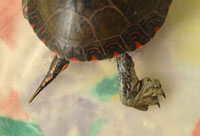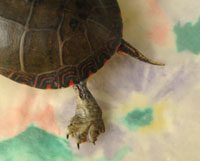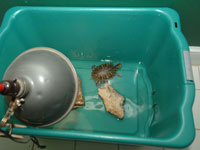I have a painted turtle whose feet look soggy and have turned a white color. The back feet are almost completely covered and the front feet are par
I have a painted turtle whose feet look soggy and have turned a white color. The back feet are almost completely covered and the front feet are partially covered. He has spent the winter in a tub with a slider turtle under a full spectrum light in about 2 inches of water with rocks for sunning. The slider turtle seems perfectly healthy. Do the turtles need to be separated and how do I treat the condition? I've included photos to help with your diagnosis.
Thanks for your help.
Jim
 Painted turtle's right foot. |
Thanks for sending the photos along with your question. I can see that your winter setup could be what started the problem. While you didn’t provide me with temperatures, I can see that you don’t have a heater for the turtle’s water and that the rocks providing the basking area are a bit on the small side for a haul-out area.
I cannot provide you with a diagnosis for your painted turtle, as that would require examination and testing, but I can certainly offer my thoughts on what has happened to your turtle and what you should do. It appears to me that your painted turtle is suffering from a type of dermatitis, which means inflammation of the skin. There are many different microorganisms that can cause an infection in the skin, including bacteria, viruses and fungi. Normally, the skin is the body’s first line of defense, protecting the body from invasion by potential pathogens. But, for example, if the temperature of the turtle’s water is too cold, or if the water is not cleaned and changed frequently, or if the turtle can’t get completely out of the water from time to time to bask and dry off, there is a chance that infectious organisms can invade the skin, resulting in dermatitis.
This is what I suspect has happened with your painted turtle. It’s interesting that two turtles, housed in the exact same environment, would have different reactions, since you said that your slider turtle appears normal at this time. It just goes to show that in addition to the environmental and husbandry issues, the immune system is also involved on whether an animal breaks with disease or remains healthy.
 Painted turtle's left foot. |
My suspicion is that the water temperature was too cold, and over time, this lowered his resistance, allowing organisms usually present in the water or on the skin, to invade the top layers, resulting in the abnormal condition to the skin. However, if he burned his feet in water that was too hot, this could also result in the changes to the skin that you’re seeing. Similarly, if his skin was exposed to some sort of harsh chemical, this could also damage the skin allowing harmful organisms to attack the skin tissue. Water turtles do benefit from spending some time out of the water, allowing the skin and shell to thoroughly dry out from time to time.
I see that you do have some small rocks to allow the turtles out of the water to bask, but the rocks don’t provide what I would consider an adequate haul-out area for their size. This may have contributed to the problem, as well. My suspicion is that your turtle is suffering from a skin infection caused either by bacteria or a fungus, or a combination of the two.
I suggest that you find a qualified herp vet in your area who can help you with your beautiful painted turtle. You should expect that your vet will perform tests, such as a Gram’s stain taken from the affected skin, possibly a bacterial and fungal culture to attempt to identify what is causing the problem, blood tests (a CBC and plasma chemistry panel) to assess the functioning of the internal organs and perhaps even a skin biopsy. Topical medication may be prescribed once testing has begun, and based on test results, systemic antibiotics and/or antifungals may also be prescribed.
 Painted turtle's winter home. |
You will be asked about your regular set-up for your turtles, and you may need to make modifications to their environment. A good setup involves heating the water, feeding them in another area so that their living quarters don’t get fouled daily, providing a filtration system to keep the water clean, also providing full-spectrum lighting (including UVB spectrum), providing a basking light and a haul-out area where your turtles can get completely out of the water to bask. It is important that you monitor the water quality and have accurate thermometers in order to keep track of the air and water temperatures.
Often turtles of similar size can share a habitat, but if you notice one picking on another, or nipping at toes or tails, or preventing another from eating, then obviously, they should be separated. It might be a good idea to separate your two turtles at this point while your painted turtle is being diagnosed and treated. Also, if the slider turtle has been hogging the haul-out area, then the painted turtle may not be getting enough time out of the water to dry off periodically.
Please make an appointment with your herp vet and have your painted turtle evaluated and tested, so that appropriate treatment can be instituted.
Need a Herp Vet?
If you are looking for a herp-knowledgeable veterinarian in your area, a good place to start is by checking the list of members on the Association of Reptilian and Amphibian Veterinarian (ARAV) web site at www.arav.com. Look for DVMs who appear to maintain actual veterinary offices that you could contact.


